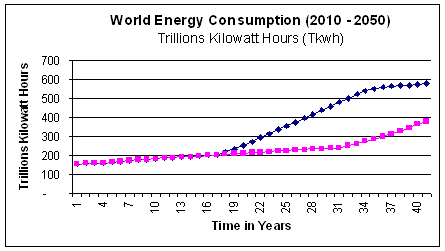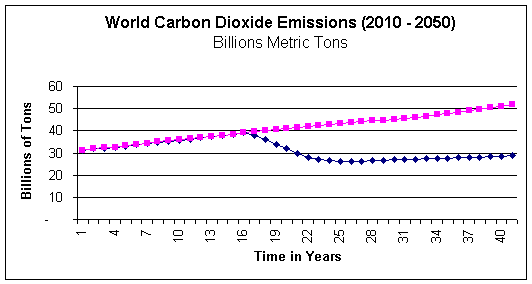World Clean Energy Plan
?Insanity is doing the same thing over and over
again and expecting different results.?
Albert Einstein
The
World Clean Energy Plan (2010 - 2050) would provide clean, efficient
energy for ten billion people, bring every country into the 21st
century, and reduce carbon dioxide emissions levels.
Clean
Power Plants along
with hydroelectric,
geothermal, solar, and wind would provide clean efficient energy. Coal,
oil, biomass, and natural gas, which are being burned and destroying
Earth?s environment, would be used to make products for billions of
people.
As
World?s population grows from 7 to 10 billion people, the World?s
energy efficiency increases from 40% to 70%. Thorium, Uranium and Mirror
Power Plants would supply countries with clean, efficient energy. Using
clean energy, cars, trucks, buses, trains, ships, airplanes for
transportation operate more efficiently. To help understand how energy
is produced and used, the metric system of kilowatt-hours is used rather
than British Thermal Units.
The
graph shows the major differences between clean and carbon energy. The
Clean Energy Consumption (blue) grows at about 4% for thirty years and
levels off at 660 trillion kilowatt hours, as world?s population on
grows to ten billion people. Every country has sufficient energy to move
into the 21st century. Using carbon energy, the International
Energy Outlook 2013 forecasts
the World Energy
Consumption (pink) grows to 400 Trillion kilowatt hours or a difference
of 260 Trillion kilowatt hours. This mean
that hundreds countries and billion of people would struggle to obtain
sufficient energy.

Projected World
Energy Consumption by U.S.
Energy Information Administration
The
graph shows the dramatic difference in carbon dioxide emissions. Using
carbon energy, the U.S.
Energy Information Administration projects
the World will be producing 50 billion metric tons (pink), compared to
using clean energy that reduces carbon dioxide emissions (pink) to less
than 30 billion metric tons or a difference of 20 billion metric tons.
If the Industrialized countries don?t use the cap and trade, carbon
dioxide emissions could be reduced in half to 15 billion metric tons.
Making
a direct comparison with the World Clean Energy Consumption and
World
Carbon Energy Consumption (2010
- 2050) would increase the energy demand by factor of six and carbon
dioxide emissions would increase to 200 billion metric tons per year.
These are clearly unacceptable alternatives.

Projected World Carbon Dioxide Emissions by
U.S.
Energy Information Administration
If
World government, business, and education leaders can
work collegiately together as they did with the establishment of the
Internet, clean
energy efficient,
electric
power, and
transportation will
create enormous environmental benefits and economic opportunities.
 |
Manufacturing facilities will assemble
10,000 clean power
plants to generate electricity, make petrochemicals from coal, biomass, &
oil, manufacture consumer & industrial products, desalt seawater for
domestic drinking water and irrigating crops, and split water directly
into hydrogen & oxygen for industrial applications.
|
 | Countries
would manufacture billions of products from some combination of the 6.8 billion tons
of coal, 33 billions barrels of oil, and
117
trillion cubic feet of natural gas rather than burning
them every year and destroying Earth's environment. Biomass
programs, which are burning billions of tons food, are simply eliminated and the food supplied to
million of starving people.
|
 | Using
the International
Energy Outlook 2013's estimate for carbon resource, a 50%
reduction in burning coal, oil, biomass and natural gas would ensure
that there would be enough carbon resources to supply the World with
consumer and industrial products for millions of years. |